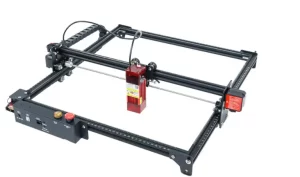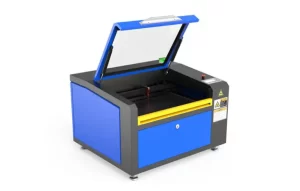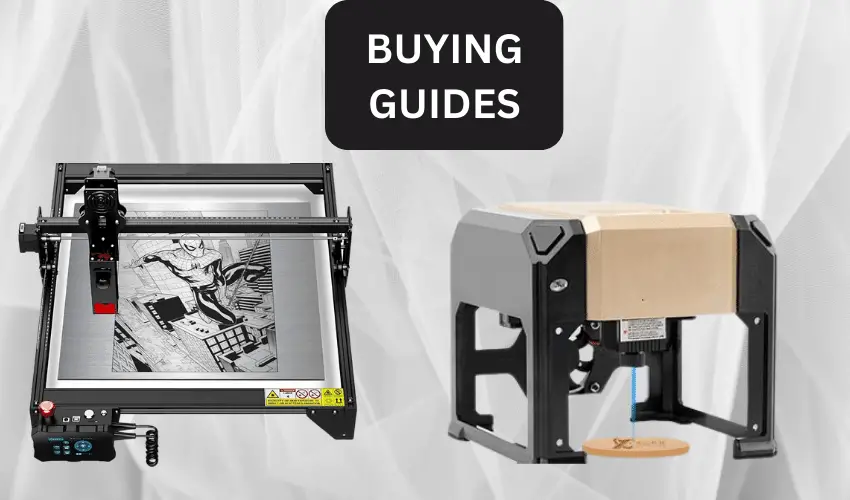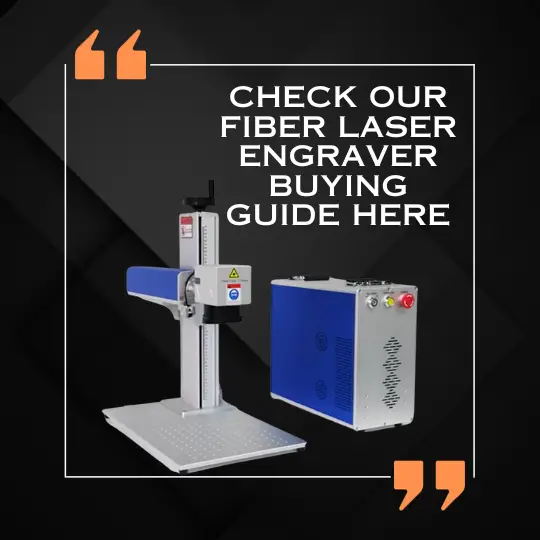In this article, discover essential tips and considerations for selecting the right laser engraver to suit your business needs. Whether you’re starting a new venture or upgrading your equipment, learn how to evaluate factors such as laser type, power and speed capabilities, engraving area size, compatibility with materials, software usability, and maintenance requirements.

Make an informed decision that aligns with your budget and production goals, ensuring your business benefits from efficient and precise laser engraving technology.
Table of Contents
A Comparison of Diode, CO2, and Fiber Lasers
Selecting the appropriate laser engraver for your business involves understanding the differences between Diode, CO2, and Fiber laser technologies. Each type offers distinct advantages and is suited for specific applications. We provide a comprehensive comparison to help you make an informed decision based on your business needs and requirements.

1. Diode Laser Engravers:
Diode lasers are compact, affordable, and ideal for engraving on materials such as wood, leather, and plastics. They operate at lower power levels (typically up to 20 watts) and are suitable for engraving small, detailed designs. Diode lasers are known for their precision and are often used in desktop engraving machines.
Applications:
- Personalized gifts and crafts (engraved photo frames, jewelry)
- Small-scale production (custom signage, promotional items)
- Detailed engraving on soft materials (wood, leather, rubber)
What materials can a Diode Laser Engrave:
Diode lasers are generally suitable for engraving on various soft and semi-soft materials. Some common materials that a diode laser can engrave include:
- Wood: Softwoods like pine and cedar, as well as hardwoods such as oak and maple.
- Acrylic: Colored acrylic sheets used for signage, displays, and artwork. Clear acrylic will require a paint coating.
- Leather: Genuine leather and synthetic leather materials used in fashion and upholstery.
- Rubber: Natural rubber and synthetic rubber materials used in stamp making and industrial applications.
- Cardboard: Various grades of cardboard and paperboard used in packaging and prototyping.
Diode lasers are particularly effective for detailed engraving and marking on these materials due to their precise beam control and lower power output compared to other laser types like CO2 and fiber lasers. However, they may not be suitable for engraving on metals or other hard materials that require higher power levels and specific laser wavelengths.
Pros:
- Cost-effective, with lower initial investment and operating costs.
- Compact and portable, suitable for small-scale operations or workshops.
- Low maintenance requirements and longer lifespan compared to other laser types.
Cons:
- Limited engraving speed and depth compared to CO2 and Fiber lasers.
- Less versatile in terms of material compatibility and engraving capabilities.
2. CO2 Laser Engravers:

CO2 lasers are versatile and widely used for engraving and cutting a variety of materials, including wood, acrylic, glass, and certain metals. They operate at higher power levels (ranging from 30 to over 100 watts) and utilize a gas mixture (CO2) to generate the laser beam. CO2 lasers offer excellent engraving speed and precision, making them suitable for both small and large-scale production environments.
Applications:
- Industrial engraving and marking (product labeling, serial numbers)
- Signage and displays (acrylic signage, architectural models)
- Customized packaging and promotional items (etched glassware, wooden boxes)
- Precision cutting of intricate designs (jigsaw puzzles, architectural models)
What materials can a CO2 Laser Engrave:
CO2 lasers are highly versatile and can engrave and cut a wide range of materials due to their wavelength and power capabilities. Some common materials that a CO2 laser can engrave include:
- Wood: Both hardwoods (e.g., oak, maple, cherry) and softwoods (e.g., pine, cedar) used in furniture, crafts, and decorative items.
- Acrylic: Clear and colored acrylic sheets used for signage, displays, point-of-sale materials, and architectural models.
- Glass: Certain types of glass can be engraved with a CO2 laser, often used for decorative glassware, awards, and promotional items.
- Paper and Cardboard: Various grades of paper, cardboard, and paperboard used in packaging, invitations, and artistic applications.
- Fabric and Textiles: Natural and synthetic fabrics can be engraved for custom apparel, textile art, and fashion accessories.
- Leather: Genuine leather and synthetic leather materials used in upholstery, footwear, and fashion accessories.
- Rubber: Natural rubber and synthetic rubber materials used in stamp making and industrial applications.
- Stone and Ceramic: Some types of stone, like slate, marble, and ceramic tiles, can be engraved for personalized gifts, memorials, and home decor.
- Certain Metals: CO2 lasers can mark certain metals with the aid of metal marking solutions or coatings. They are not typically used for deep engraving or cutting metals but can create surface markings and etchings.
CO2 lasers are prized for their ability to handle a wide variety of materials with high precision and speed, making them popular across industries such as manufacturing, signage, crafting, and personalized gift production.
Pros:
- High engraving speed and efficiency, capable of handling large volumes of work.
- Versatile, with the ability to engrave and cut a wide range of materials.
- Well-suited for intricate designs, fine details, and deep engraving.
Cons:
- Higher initial investment and operational costs compared to Diode lasers.
- Requires regular maintenance and periodic replacement of consumables (laser tubes, optics).
3. Fiber Laser Engravers:

Fiber lasers are renowned for their superior marking and engraving capabilities on metal surfaces, including stainless steel, aluminum, and brass. They utilize optical fibers to generate the laser beam, which is highly concentrated and precise. Fiber lasers operate at higher power levels (typically 20 watts and above) and are designed for marking rather than cutting applications.
Applications:
- Metal engraving (industrial parts marking, tool identification)
- Medical device marking (surgical instruments, implants)
- Automotive and aerospace components (engraving serial numbers, logos)
- Jewelry customization (engraving on precious metals)
Pros:
- Exceptional marking quality and precision on metal surfaces.
- High reliability and minimal maintenance requirements.
- Fast engraving speeds and ability to produce durable, corrosion-resistant marks.
Cons:
- Limited versatility compared to CO2 lasers, primarily suitable for metal engraving.
- Higher initial investment and specialized knowledge required for operation.
Comparison of Capabilities:
Laser engraving technology has revolutionized the way we customize and create intricate designs on various materials. Each type of laser engraver—Diode, CO2, and Fiber—offers unique capabilities and applications suited for different industries and projects. In this section, we’ll delve into material compatibility, engraving speed and detail as well as cost and maintenance of each type of laser engraver and compare their strengths and uses.
Material Compatibility:
- Diode lasers: Ideal for soft materials like wood and acrylic.
- CO2 lasers: Versatile, suitable for engraving and cutting a wide range of materials.
- Fiber lasers: Specialized in marking and engraving metals with high precision.
Engraving Speed and Detail:
- Diode lasers: Lower power and slower engraving speed, best for detailed designs on small items.
- CO2 lasers: Faster engraving speeds and capable of handling large volumes with high detail.
- Fiber lasers: Fast marking speeds with exceptional detail and sharpness on metal surfaces.
Cost and Maintenance:
- Diode lasers: Lower initial cost and minimal maintenance.
- CO2 lasers: Higher initial investment but versatile and cost-effective for various applications.
- Fiber lasers: Higher initial cost, low maintenance, and cost-effective for metal engraving.
Choosing the Right Laser Engraver for Your Business

Investing in a laser engraver is a significant decision for any business or hobbyist looking to enhance their capabilities in customization and precision marking. With a multitude of options available, selecting the perfect laser engraver requires careful consideration of several key factors. We will summarize the essential steps to help you make an informed purchasing decision.
1. Define Your Engraving Needs:
Begin by identifying the primary purpose and scope of your engraving projects. Consider the types of materials you will be engraving (wood, acrylic, metal), the size and complexity of designs, and your anticipated production volume. This initial step will provide clarity on the specifications and features you require in a laser engraver.
2. Types of Laser Engravers:
Understand the different types of laser engraving technologies available:
- Diode Lasers: Ideal for small-scale projects and engraving on soft materials like wood and plastics.
- CO2 Lasers: Versatile and suitable for engraving and cutting a wide range of materials, including wood, acrylic, and some metals.
- Fiber Lasers: Specialized in marking and engraving on metal surfaces with high precision.
Choose a laser type based on your specific application requirements, material compatibility, and desired engraving capabilities.
Check Our Buying Guides For Detailed Information Here
3. Laser Power and Speed:
Laser engravers are categorized by their power output, typically measured in watts. Higher wattage lasers offer faster engraving speeds and the ability to handle thicker materials. Consider your production needs and the level of detail required in your designs when selecting the appropriate laser power for optimal performance.
4. Engraving Area Size:
Evaluate the size of the engraving area (bed size) needed for your projects. Ensure the laser engraver’s dimensions accommodate the largest workpieces you plan to engrave. A larger engraving area provides flexibility for handling various sizes of materials and designs.
5. Material Compatibility:
Verify that the laser engraver is compatible with the materials you intend to work with. Different lasers are designed for specific materials, and some may offer versatility across a range of substrates. Ensure the machine supports both engraving and cutting functions if required for your applications.
6. Software and User Interface:
Assess the usability of the laser engraver’s software interface. Look for features such as intuitive design tools, compatibility with vector graphic formats (e.g., AI, SVG, DXF), and ease of importing and editing designs. User-friendly software enhances workflow efficiency and reduces learning curves for operators.
7. Engraving Precision and Resolution:
Consider the engraving resolution and precision capabilities of the laser engraver. Higher resolution machines produce finer details and sharper edges, essential for intricate designs, small text engraving, and detailed logos. Test the machine’s engraving quality to ensure it meets your standards before making a purchase.
8. Maintenance and Support:
Evaluate the maintenance requirements and availability of technical support for the laser engraver. Regular upkeep, such as cleaning optics and replacing consumables (e.g., lenses, laser tubes), ensures consistent performance and extends the machine’s lifespan. Reliable customer support is crucial for troubleshooting and resolving issues promptly.
9. Budget Considerations:
Determine your budget for purchasing a laser engraver, taking into account not only the initial cost but also ongoing operational expenses and potential return on investment (ROI). Consider the cost-effectiveness of the machine in relation to its capabilities, durability, and long-term performance.
10. Reviews and Recommendations:
Research customer reviews, testimonials, and recommendations from businesses or hobbyists using similar laser engravers. Feedback from other users can provide valuable insights into reliability, performance, and overall satisfaction with the equipment.
11. Future Growth and Scalability:
Anticipate future business growth and scalability when selecting a laser engraver. Choose a machine that can accommodate expanding production needs, offers upgrade options, additional features, or compatibility with advanced technologies as your operations evolve.
Conclusion
By following these steps and considering these factors, you can confidently select the right laser engraver that aligns with your business goals, enhances your capabilities, and delivers high-quality results in customizing and creating precision-engraved products across various industries. A well-chosen laser engraver not only improves productivity but also opens up new opportunities for innovation and creativity in your business endeavors.

